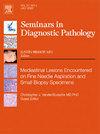角化细胞瘤:一种罕见唾液腺肿瘤的分子见解和诊断挑战
IF 3.5
3区 医学
Q2 MEDICAL LABORATORY TECHNOLOGY
引用次数: 0
摘要
角化瘤是一种罕见的良性唾液腺肿瘤,由Nagao等人于2002年指定为一种新的实体。最近,RUNX2基因重排作为一种特征性遗传改变的发现,确立了其作为一种独特肿瘤的分类,巩固了角化细胞瘤在第5版WHO头颈部肿瘤分类中的纳入。临床上,角化细胞瘤发生在广泛的年龄范围内,但在年轻人中最普遍,没有明显的性别偏好。它通常表现为生长缓慢的腮腺肿块。组织学上,肿瘤的特征是多室囊性病变,内衬层状鳞状上皮,无异型性,缺乏颗粒细胞层。除了囊肿形成外,纤维间质内也可观察到鳞状上皮巢,有时伴随有鳞状化生样过程的唾管。免疫组织化学,与正常鳞状上皮相似,肿瘤细胞p63阳性,肌上皮标记物(包括SMA、钙钙蛋白和S-100)阴性。Ki-67标记指数低,p53表达呈野生型。鉴别诊断包括广泛的条件,从非肿瘤性病变到由鳞状上皮组成的良性和恶性肿瘤。包括鳞状细胞癌、黏液表皮样癌、化生沃辛瘤、鳞状分化多形性腺瘤、皮样囊肿、表皮囊肿/胆脂瘤和坏死性唾液化生。虽然详细的组织形态学检查对诊断至关重要,但RUNX2基因重排检测有望在角化囊瘤的鉴别诊断中发挥关键作用。需要更多的病例来更好地了解这种罕见的唾液腺肿瘤。本文章由计算机程序翻译,如有差异,请以英文原文为准。
Keratocystoma: Molecular insights and diagnostic challenges in a rare salivary gland tumor
Keratosytoma is a rare, benign salivary gland tumor designated as a new entity by Nagao et al. in 2002. Recently, the discovery of RUNX2 gene rearrangement as a characteristic genetic alteration has established its classification as a distinct neoplasm, solidifying the inclusion of keratocystoma in the 5th edition of the WHO classification of Head and Neck Tumors. Clinically, keratocystoma occurs across a broad age range but is most prevalent among younger individuals, with no significant sex predilection. It typically presents as a slow-growing parotid mass. Histologically, the tumor is characterized by a multilocular cystic lesion lined by stratified squamous epithelium without atypia and lacks a granular cell layer. In addition to cyst formation, nests of squamous epithelium enclosed within fibrous stroma are also observed, sometimes along with salivary ducts with squamous metaplasia-like processes. Immunohistochemically, similar to normal squamous epithelium, tumor cells are positive for p63 and negative for myoepithelial markers, including SMA, calponin, and S-100. The Ki-67 labeling index is low, and p53 expression exhibits a wild-type pattern. The differential diagnosis encompasses a wide spectrum of conditions, ranging from non-neoplastic lesions to benign and malignant tumors composed of squamous epithelium. These include squamous cell carcinoma, mucoepidermoid carcinoma, metaplastic Warthin tumor, pleomorphic adenoma with squamous differentiation, dermoid cyst, epidermal cyst/cholesteatoma, and necrotizing sialometaplasia. Although a detailed histomorphological examination is essential for the diagnosis, testing for RUNX2 gene rearrangement is expected to play a pivotal role in the differential diagnosis of keratocystoma. More cases are necessary to better understand this rare salivary gland tumor.
求助全文
通过发布文献求助,成功后即可免费获取论文全文。
去求助
来源期刊
CiteScore
4.80
自引率
0.00%
发文量
69
审稿时长
71 days
期刊介绍:
Each issue of Seminars in Diagnostic Pathology offers current, authoritative reviews of topics in diagnostic anatomic pathology. The Seminars is of interest to pathologists, clinical investigators and physicians in practice.

 求助内容:
求助内容: 应助结果提醒方式:
应助结果提醒方式:


